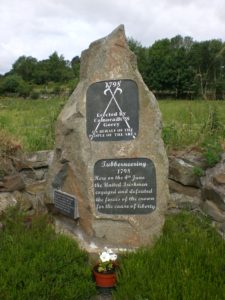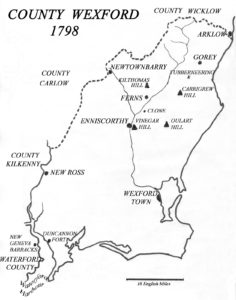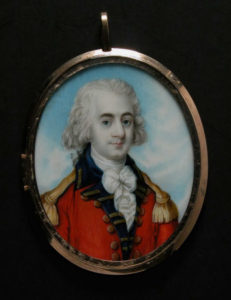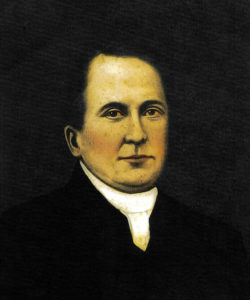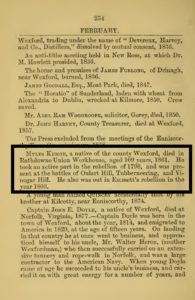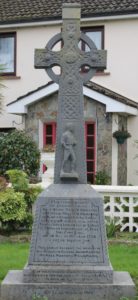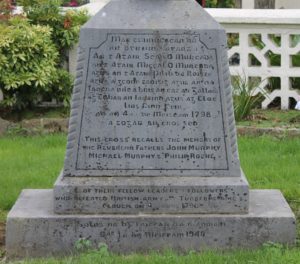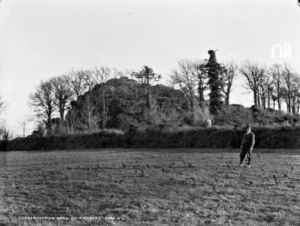Battle of Tubberneering
The Battle of Tubberneering was fought on 4th June 1798 between the Crown forces and United Irish rebels at Tubberneering, North Co. Wexford. The insurgents, under the command of Fr. John Murphy, ambushed and routed 600 men comprised of one troop of regular cavalry, the 4th Royal Irish Dragoon Guards, and militia and yeomanry auxiliaries under the command of Lieutenant-Colonel Walpole.
The United Irish rebels had been encamped on Mr. Donovan’s lands at the foot of Corrigrew Hill, under Fr. Murphy’s command, on the 2nd and 3rd of June. This small respite from hostilities and marching afforded the rebels some rest and time to re-group from previous skirmishes. Some of the rebels took leave to visit their families during these two days before re-joining the camp in advance of their move North towards Gorey.
On the morning of the 4th of June, Lieutenant-General Loftus and Lieutenant-Colonel Walpole marched out of Gorey with 1200 men with the intention of attacking the rebel encampment at Carrigrew. Lieutenant-General Loftus led his 600 men out the Ballycanew road to attack the camp from the East while Lieutenant-Colonel Walpole headed due south via Clough to attack the camp on its northern side.
Having received advanced warnings of the British plans, the poorly equipped rebel army of 10,000 to 12,000 men set out from Carrigrew Hill and marched through Ballyoughter on to Tubberneering. Their aim was to defeat the Crown forces in Gorey and release rebel prisoners that had been captured and imprisoned there.
On approaching Tubberneering, a vanguard of rebels was warned by a scouting party returning from Clough that the British forces were heading their way. The vanguard set up an ambush with musketeers on top of the rock at Tubberneering and pikemen laying in wait inside the ditch along the road south of Cain bridge.
When Walpole and his army came round the the bend at Cain, the musketeers opened fire and a bloody battle ensued, leaving Colonel Walpole and 100 of his men dead. The remaining soldiers threw away their weapons and uniforms and fled into the countryside to safety, mainly in the direction of Gorey. The spoils of battle for the rebels comprised of three cannons and a large ammunition supply. The cannons were subsequently used against British troops at Gorey and, later, in the Battle of Arklow.
There are many books written on the 1798 Rebellion with differing accounts of the events at Tubberneering. Some suggest that Walpole was killed at Tubberneering while others claim he was killed at Clough having retreated from the battle front and awaiting reinforcements from General Loftus.
If you wish to read a very detailed and well researched book on the Rising, purchase a copy of ‘The Peoples’ Rising, Wexford 1798′ by Wexford native and renowned historian Daniel Gahan. The author researched a vast number of primary and secondary sources to provide a gripping insight into the rebellion.
The Memoirs of Miles Byrne provides an insurgent’s insight into the reality of the 1798 Rebellion battles. Follow the story of the Battle of Tubberneering from the day before the battle when the insurgents were encamped on Carrigrew Hill through to the end of the battle. Turn to Page 72 in the memoirs (Page 88 in the pdf document) for the account. This publication is made available courtesy of the Internet Archive and is in the Public Domain.
The Schools Collection on Dúchas.ie
Read about the ‘The Battle of Ballyoughter’ on the Dúchas Schools Collection.
Archive Newspaper Articles on 1798 Commemorations
Newspaper images are reproduced with the kind permission of MediaHuis (formerly Independent News and Media PLC).
1798 Images
Father Murphy
Fr. Murphy was one of the renowned leaders of the 1798 Rebellion and one of the Irish martyrs who died for the cause of Irish freedom.
He was born at Tincurry, Co Wexford, studied at Seville and was ordained as a priest. Upon return to Ireland in 1795, he was installed as the parish priest of Boolavogue.
Fr. Murphy proved to be a great military man and demonstrated his leadership qualities and military intelligence in battles against the Crown forces. His rebels used tactics such as placing their hats upon their pikes to draw British gun fire, allowing them to attack before the Crown forces reloaded. He also used ‘the cattle stampede’ tactic when besieging towns, creating cover and confusion during which the rebels stormed the defences.
Famously, Fr. Murphy is commemorated in the ballad ‘Boolavogue’, which was written in 1898 to commemorate the centenary of the rebellion. His body is interred in the old graveyard in Ferns, Co Wexford.
1798 Claims List
In the aftermath of the 1798 rebellion, people who claimed to be on the loyalist side sought compensation from the government for losses and damages sustained in the fighting.
Below, you will find a list of claimants for the wider Ballyoughter area. There is much to be deduced and learned from the list. You will note that the claimants mainly come from two townlands, Ballymore and Tubberneering. This is expected given that the rebel camp was based on Corrigrew Hill, Ballymore for several days in advance of the march through Ballyoughter and on to where the battle took place in Tubberneering.
Reading the items listed as ‘Lost’ and the amount claimed hints at the destruction inflicted on the communities during the insurrection. The rebellion pitted neighbour against neighbour and one can only imagine the repercussions for community relations when the rebellion ended. It is noteworthy also that certain townlands along the way appear to be untouched by the march towards battle, perhaps indicating loyalty to the rebellion. However, it could also be argued that there are no claimants from these areas because people did not wish to be classed as loyalists by staking a claim.
There are two recorded killings from the civilian population in the area. Margaret Stanford’s husband was killed by insurgents at Tubberneering leaving her with 5 children. Mr. Tompkins from the neighbouring townland of Ballygullen was murdered by rebels.
Transcribed from the original documents held in the National Library of Ireland.* Courtesy of historian Ian Cantwell.
*Misspelled words are due to exact transcription.
If the table below does not show its contents, please refresh the page and the contents should appear.
Surname | Occupation | Townland | Lost | Sum ClaimeD (Allowed) £.s.d. |
|---|---|---|---|---|
Hill, John | Farmer | Tubberneering | Potatoes, Furniture, Corn, Profit of Cows, Provisions | 60/4/4 (60/3/6) |
Davis, William | Farmer | Tubberneering | Crop, Corn, Profit of Cows, Potatoes, Turf | 22/2/6 (22/2/6) |
Hill, Mary | Tubberneering | Bed, Cloaths, Furniture, Tobacco, Cash | 29/2/10 (29/2/10) | |
Hill, Thomas | Carpenter | Tubberneering | Beds, Cloaths, Books, Furniture, Linen | 50/14/0 (50/6/5) |
Radwell, Patience | Servant | Tubberneering | Cloaths | -/17/6 (-/17/6) |
Moulds, Anne | Tubberneering | Cloaths | 7/3/6 (7/3/6) | |
Dobbin, Bartholomew | Farmer | Tubberneering | House, Offices, Furniture, Cloath, Mare, Provisions | 85/8/8 |
Dobbin, Elizabeth | Widow | Tubberneering | House, Furniture, Cloaths, Corn, Crop, Profit of Cows | 127/14/10 |
Rynhart, Henry | Farmer | Tubberneering | Cloaths, Provisions, Furniture | 18/15/4 |
Rynhart, Henry Snr. | Farmer | Tubberneering | Cattle, Cloaths, Furniture, Provisions | 70/16/1 (65/11/-) |
Rynhart, Mary | Widow | Tubberneering | Cash, Cloaths, Provisions, Furniture | 35/18/3 (34/3/8) |
Rynhart, Peter | Linen Weaver | Tubberneering | Wearing Apparel, Bed, Bedding, Cash | 33/11/8 (33/11/8) |
Standford, John | Tubberineering | Cloaths, Furniture, Farming Utensils, Potatoes | 19/14/2 (19/14/2) | |
Stedmond, Nathaniel | Farmer | Tubberneering | Furniture, Cloaths, Profit of Cows, Corn | 38/14/1 (37/18/1) |
Stedmond, Jane | Tubberneering | Cloaths | 6/8/6 (6/8/6) | |
Stedmond, Michael | Carpenter | Tuberneering | Cloaths, Saw | 4/13/4 (4/13/4) |
Taylor, Elinor | Tubberneering | Furniture, Crops growing, Cloaths | 57/0/3 (56/7/8) | |
Taylor, Robert | Shoemaker | Tubberneering | Leather, Working Tools, Loss of Trade | 14/19/0 (6/3/0) |
Fennell, John | Tubberneering | Houses burned, Two Colts | 77/14/10 | |
Rynhart, Humphry | Ballygullin | Cattle, Cloaths, Furniture, Provisions | 22/1/6 (16/17/6) | |
Hill, William | Yeoman | Ballygullin | Cloaths, Bed, Bedding, Shop Drawers and Weights | 55/16/17 |
Tompkins, Jane | Widow | Ballygullin | House, Furniture, Cloaths, Profit of Cows, Debts, Cattle, Car, Tackling | 250/3/3 (205/15/3) |
Tompkins, William | Farmer | Ballygullin | Crop, Profit of Cows, Cloaths, Cattle, Car, Tackling | 273/12/1 (240/12/2) |
Donovan, Richard | Esquire | Ballymore | Horses, Carriages, Corn, Crop, Wine, Spirits, Cloaths | 498/13/3 |
Bass, Ann | Shopkeeper | Ballymore | Shop Goods, Horse, Cloaths, House Linen | 718/14/1 (692/12/1) |
Fitzhenry, John | Farmer | Ballymore | Crop, Cattle, Corn, Profit of Cows, Provisions | 109/15/3 |
Hawkins, George | Farmer | Ballymore | Provisions, Corn, Crop, Furniture, Cloaths | 30/14/11 |
Lynch, James | Ballymore | Cloaths, Books | 5/14/0 | |
Moulds, Edward | Servant | Ballymore | Cloaths, Cash | 12/19/4 |
Restrich, William | Ballymore | Cloaths, Furniture Repairs | 16/3/5 (16/3/5) | |
Rinehart, John | Farmer | Ballymore | Cloaths, Meadowing, Potatoes, Provisions | 25/17/7 (24/7/7) |
Swain, William | Shoemaker | Ballymore | Furniture, Cloaths, Cattle, Crop, Leather, Tools | 46/12/8 (46/12/8) |
Winter, James | Ballymore | Corn, Hay destroyed, Cloaths | 5/17/6 | |
Rigley, Mary | Widow | Cain | Furniture, Provisions, Cloaths | 27/10/8 (27/10/8) |
Owen, Roger Rev. | Rector | Toome | Cattle, Oats, Provisions, Wearing Apparel | 248/8/10 |
